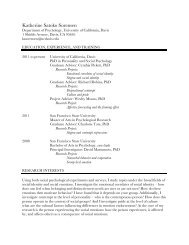SMART Board User's Guide - Psychology
SMART Board User's Guide - Psychology
SMART Board User's Guide - Psychology
Create successful ePaper yourself
Turn your PDF publications into a flip-book with our unique Google optimized e-Paper software.
Writing, Capturing and Erasing<br />
You can create or erase annotation objects using the styluses and eraser in the Pen Tray,<br />
the various tools available in Notebook software, or a combination of both.<br />
This section describes how to:<br />
• create annotations by writing over top of Windows applications projected on your<br />
interactive whiteboard using the Pen Tray tools or their software counterpart − the<br />
Floating Tools<br />
• configure the Pen Tray tools<br />
• create a user profile to save your reconfigured Pen Tray and Floating Tools settings<br />
(Windows operating system only)<br />
• capture an image of your annotations into <strong>SMART</strong> Notebook software<br />
• erase what you’ve written on the interactive whiteboard<br />
• use a smooth-ink setting to eliminate jagged lines<br />
Writing with Pen Tray Styluses over Applications<br />
Start up an application on your projected interactive whiteboard, select one of the four<br />
colored styluses from the Pen Tray, and then write in the color you selected. If you’re using<br />
regular dry-erase markers, be sure to leave the caps securely on, as you’re writing in virtual,<br />
electronic ink rather than physical ink.<br />
To write in a different color, place the stylus you first used back in its slot and select<br />
another. Since the color recognition comes from the slots in the Pen Tray rather than the<br />
styluses themselves, ensure that each stylus is returned to its proper slot (the slot with the<br />
corresponding color) when you finish using it.<br />
WARNING: If you touch the board after writing over a non-board-aware application (and<br />
replacing the stylus in the Pen Tray), the annotations you just made will disappear. While this<br />
is an easy way to clear the screen of all external annotations, you must be careful not to<br />
inadvertently delete annotations by accidentally touching the board. However, if you’ve<br />
accidentally lost annotations by touching the board, don’t panic: you can easily restore the<br />
lost annotations. To do this, open the Floating Tools and press the Restore Annotations<br />
button in the Floating Tools palette. The last cleared annotation will be restored to view.<br />
Win<br />
Press to restore last<br />
cleared annotation<br />
Mac<br />
OS X<br />
Press to restore last cleared<br />
annotation<br />
Tip<br />
You can write and erase<br />
on the board with your<br />
finger. Just pick up a<br />
stylus or the eraser from<br />
the Pen Tray and touch<br />
the board with your other<br />
hand. Any pressure<br />
applied to the board after<br />
a tool has been lifted<br />
produces the behavior of<br />
the lifted tool.<br />
<strong>SMART</strong> <strong>Board</strong> User’s <strong>Guide</strong> 17
















